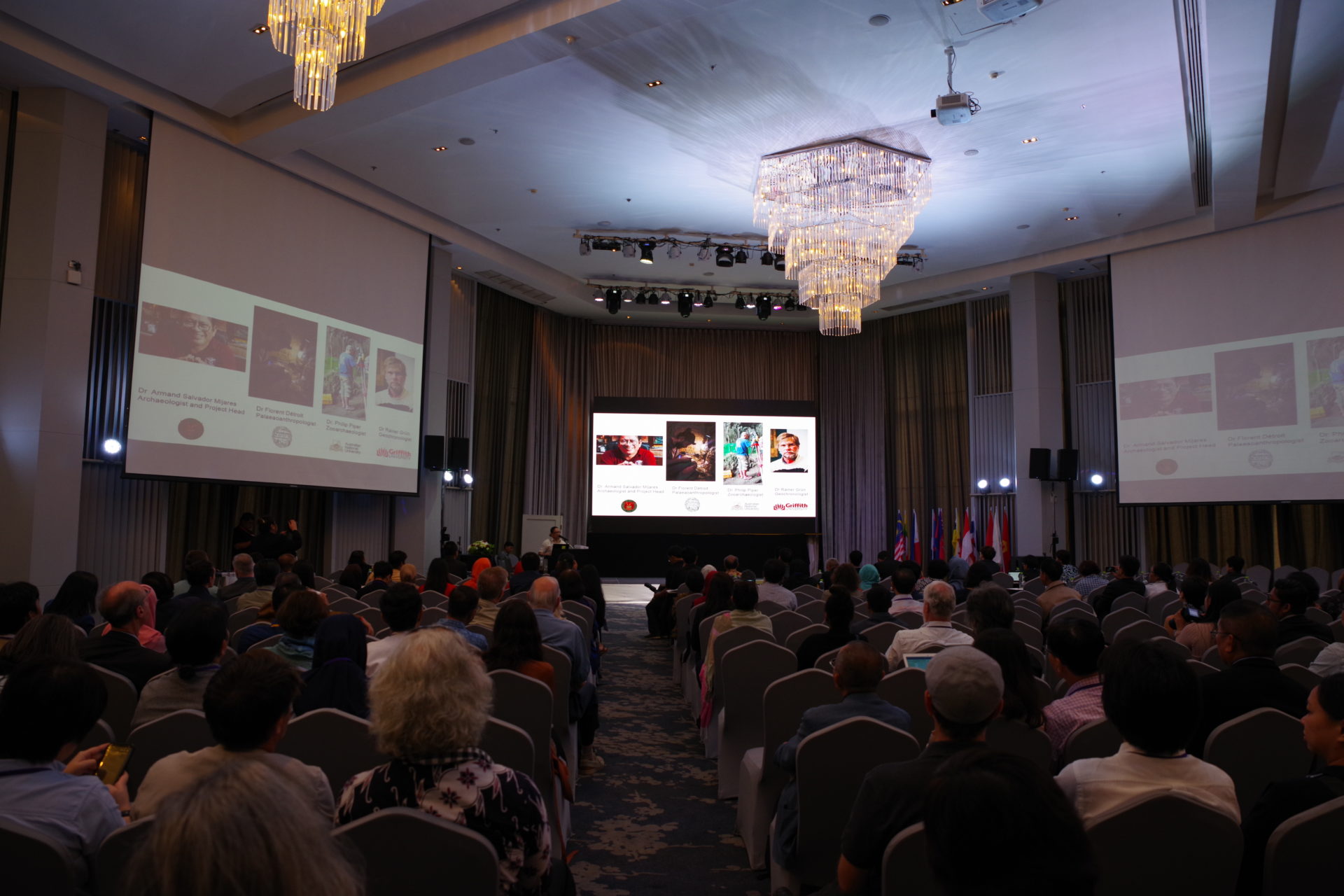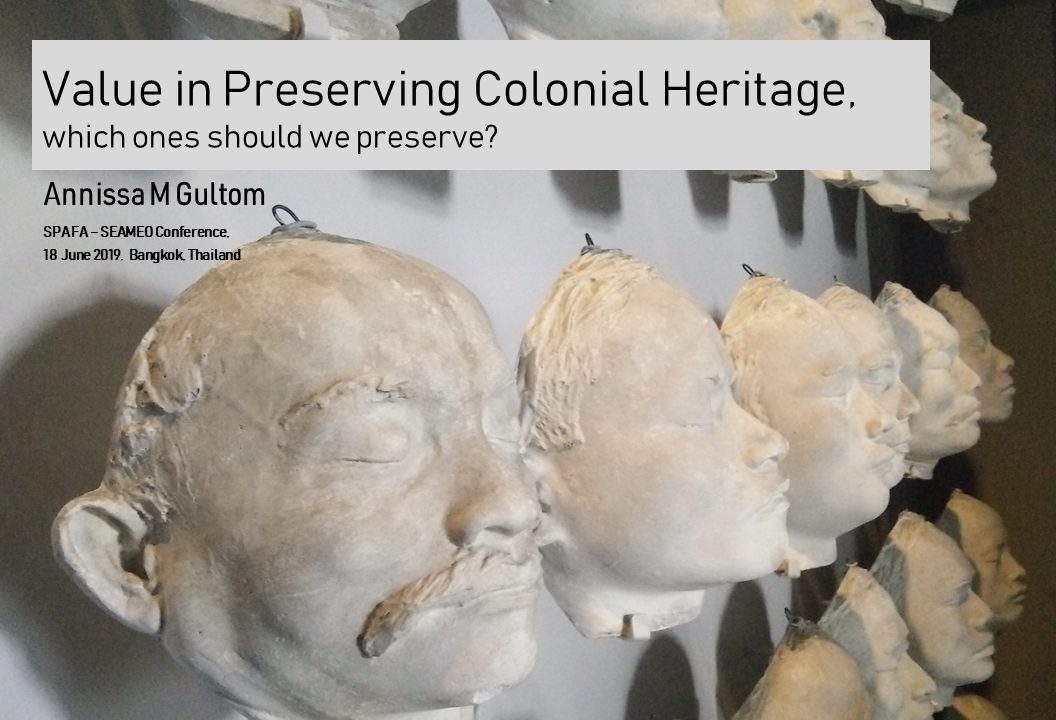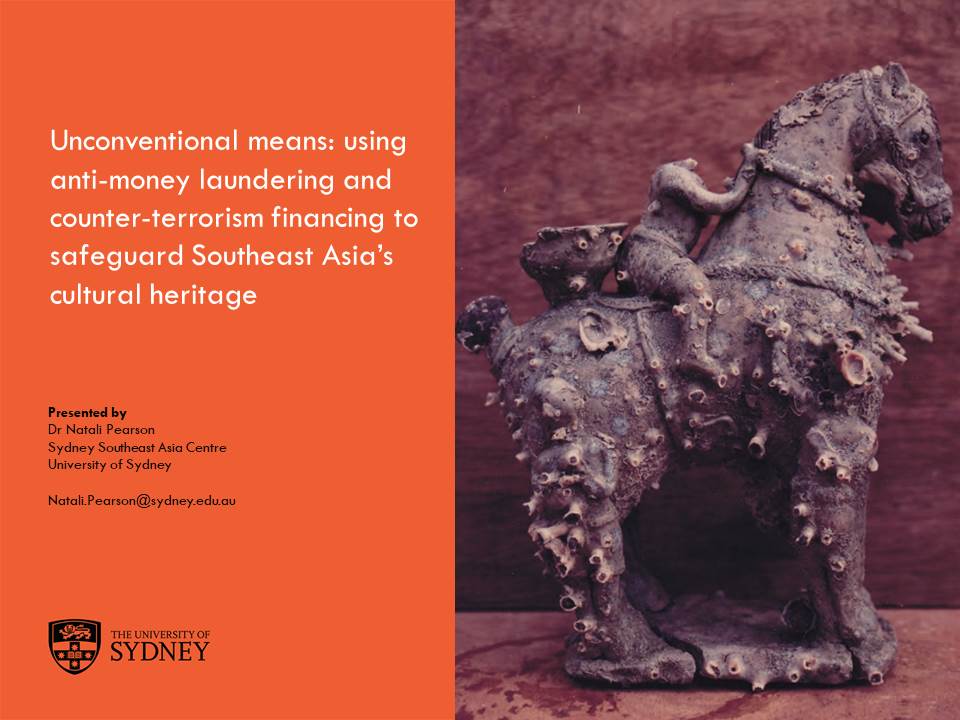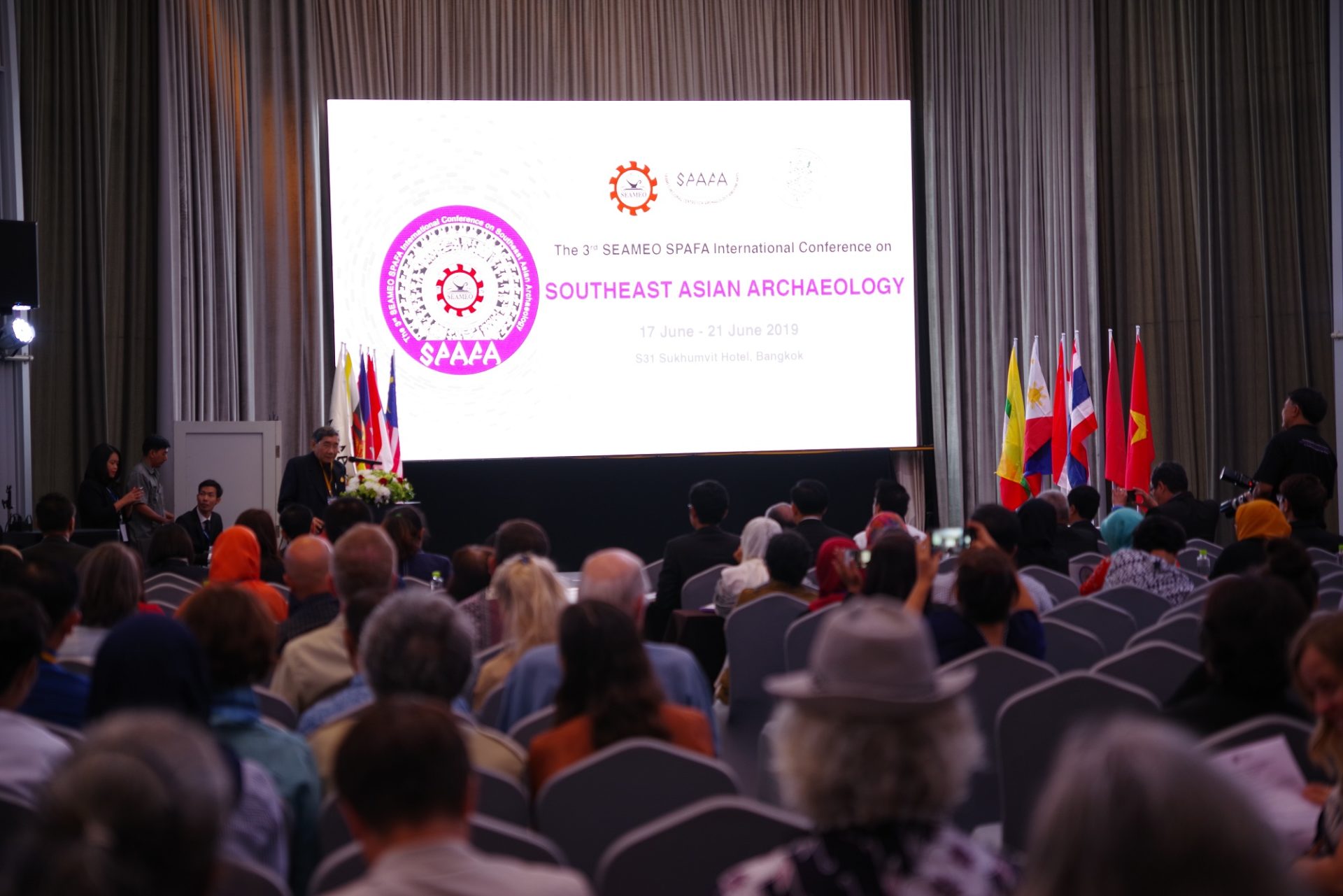【亞太博物館連線專欄】東南亞博物館新知:博物館怎麼去殖民化?怎麼用反洗錢措施捍衛文化資產?
Southeast Asia Museum New Knowledge: How Does Museum Decolonize? How to Use Anti-Money Laundering Measures to Safeguard Cultural Heritage?
東南亞博物館新知:博物館怎麼去殖民化?怎麼用反洗錢措施捍衛文化資產?
Southeast Asia Museum New Knowledge: How Does Museum Decolonize? How to Use Anti-Money Laundering Measures to Safeguard Cultural Heritage?
作者:Siriwat Pokrajen(文書官∕SEAMEO SPAFA東南亞教育部長組織考古及美術區域中心) 編輯:田偲妤
SEAMEO SPAFA東南亞考古國際研討會(SEAMEO SPAFA International Conference on Southeast Asian Archaeology, 簡稱SPAFACON)每三年於曼谷舉辦,是學者分享及傳遞考古研究知識、激發文資推廣保護新思的重要平台。每年,博物館的營運及東南亞文物、古物的捍衛都是會中重要主題。本文將簡短說明SEAMEO SPAFA的博物館相關工作,隨後介紹於SPAFACON2019發表的兩篇論文,皆深具啟發性,其一探討現在博物館去殖民化的趨勢,其二提出一種保護文化資產的革新作法。
關鍵字:古物、文化資產、保存、考古、去殖民化
Held every three years in Bangkok, Thailand, the SEAMEO SPAFA International Conference on Southeast Asian Archaeology (SPAFACON) is a major avenue for scholars to share and disseminate archaeological research and propose new ideas about cultural heritage promotion and protection. Each year, papers concerning the operations of museums and the safeguarding of Southeast Asian artefacts and antiquities form an important component of the conference. This article gives a brief introduction to the work of SEAMEO SPAFA in relation to museums before presenting two stimulating papers presented at SPAFACON2019, one addressing the current trend of decolonizing museums and the other proposing an unconventional means of protecting cultural heritage.
Keywords: antiquity, cultural heritage, conservation, colonialism, decolonization
什麼是SEAMEO SPAFA?從考古、美術、文資進入博物館世界
談到博物館,通常想到的就是文化資產的世界,而這個領域涉及的知識及技能包羅萬象。根據仍在草擬中的《針對文化世界遺產點的聯合國教科文組織能力架構》(UNESCO Competency Framework for Cultural World Heritage Sites),管理、保存考古歷史遺跡及其物品,需要眾多專精的技術能力,即人類學、考古學、建築、傳統手工藝、發展規劃、工程、地理∕文化地景、無形文化資產、地景設計、材料保存、博物館學及都市研究。這個架構與博物館的經營息息相關,因為它提供一份相當完善的清單,涵蓋任何博物館都可能需要培養的領域。現在的博物館既然內容越來越多元,就需擁有廣泛的知識體系,才能妥善照顧並呈現其典藏,發展合適的教育推廣計畫。
東南亞教育部長組織考古及美術區域中心(SEAMEO SPAFA)1有三大旗艦計畫,即針對考古的「促進東南亞考古學」(Advancing Southeast Asian Archaeology)、針對美術的「神聖宇宙」(Sacred Universe)以及針對文資與保存的「熱帶裡的保存」(Conservation in the Tropics),計畫執行面已涵蓋上段所述的大多領域。事實上本中心活動的許多受益者,不論是提供資源方抑或參與方,都不侷限於考古學家、藝術家或文資保存工作者,不同職責的博物館專業人士皆有受惠。他們各自的專精領域豐富了我們的計畫,他們的參與也使整體文資前景更加欣欣向榮。
自1970年代成立以來,從試圖建立博物館的區域網絡以促成合作計畫,到推廣機構內部研究,再到加強典藏管理、保存相關的專業知識技能,SEAMEO SPAFA一直於各項工作與博物館行政人員、策展人、教育人員及保存工作者合作。我們早期的活動主要著重文物保存,例如:銅器、陶器、水下考古出土物、傳統手工藝及有機材料的培訓課程與工作坊。這些活動多在1970年代末及1980年代初舉辦,當時在東南亞這類型的知識較為缺乏,而這些活動使SEAMEO SPAFA在文資保存方面,成為首屈一指的區域組織。我們的一大成就是於2002年,與總部位於羅馬的「文化資產保存修復研究國際中心」(International Centre for the Study of the Preservation and Restoration of Cultural Property, ICCROM)共同發起CollAsia計畫。雖然2012年後SEAMEO SPAFA不再參與CollAsia,這項重要的教育計畫仍持續培力東南亞的文資典藏專才。
SPAFACON2019:拓展東南亞博物館與文資知識
SEAMEO SPAFA東南亞考古國際研討會(SPAFACON)是我們考古旗艦計畫下的重點專案,每三年於曼谷舉辦,是這個地區唯一定期舉辦的國際研討會。我們尤其歡迎相關領域的東南亞考古學者,特別是可能缺乏機會於地區外發表研究或新構想者。

第三屆SEAMEO SPAFA東南亞考古國際研討會於2019年6月17至21日舉辦,博物館專業人士、考古學家及其他與會人士前來共襄盛舉,一同拓展東南亞文化資產知識。研討會依據通過審查的論文主題分為23個場次,博物館相關研究多發表於第12場「東南亞的殖民文化資產:目前的研究、保存及管理」(Colonial Heritage in Southeast Asia: Current Research, Conservation and Management)及第21場「文化資產管理之法規政策:倫理及文物返還觀點」(Law and Policy in Heritage Management: Perspectives in Ethics and Repatriation)。以下兩份論文分別來自這兩個場次,應能啟發博物館及文資專業人士思考其領域目前的狀態,探索如何對其工作相關的議題對話有所貢獻。
保留殖民文化資產的價值—我們該保留哪些價值?
發表人:Annissa M. Gultom(阿拉伯聯合大公國,拉斯海瑪國政府古物及博物館部,拉斯海瑪國家博物館館長兼博物館經理)

第12場發表的研究,多與發表人建議保存的殖民歷史遺跡有關,而且著重於這些地點的物質性特徵,對於各自國家的殖民化則簡短帶過。Gultom則更詳盡地敘述印尼殖民史,對於保存殖民文化資產的價值提出較為尖銳的問題。她先細述鮮少為人提及的班達島(Banda Island)原住民大屠殺,即印尼第一起殖民暴力事件。進而質疑若放在現代,荷蘭東印度公司(Dutch East India Company, VOC)總督兼巴達維亞(Batavia,今雅加達)建立者Jan Pieterszoon Coen是否應算戰爭犯,而非替東印度公司及荷蘭帶來榮景的英雄。她接著批評於荷蘭的美術館內,荷蘭殖民主義的呈現多經過篩選,抹去暴力鎮壓的痕跡,而且展覽中仍存在種族歧視的元素。
Gultom雖未直接回答其論文標題的提問,她發表過程中提出的許多問題,應能啟發我們進一步討論,曾經的殖民地可以如何處理過去及殖民文資。有鑑於西方博物館正在發生的去殖民化趨勢,她提出一個重要問題:過去殖民地的博物館是否也該從善如流(又應以什麼方式進行)?Gultom舉例自己2017年於雅加達歷史博物館(Jakarta History Museum)策劃的一個展覽,當中她選擇強調印尼殖民主義暴力的歷史,過去印尼的博物館很少呈現這一面,她也重新檢視印尼被殖民過程中的關鍵事件及人物。Gultom特別提到,荷蘭同仁曾抱怨這個展覽過於「血腥」,但她認為展示內容提供了對於過去更真實的描述。
根據Gultom的論文,有幾個問題可以讓我們深思。首先,對於曾為殖民國或殖民地的博物館來說,博物館及典藏去殖民化的意義究竟是什麼?博物館典藏去殖民化、博物館展覽使用政治正確的文字後,一般人對於殖民主義的理解就會有所不同嗎?博物館如何同時幫助殖民國彌補其過去,也幫助殖民地療傷呢?而這該是博物館扮演的角色嗎?前殖民地的博物館是否也應更加關注本國對於其他領土的殖民呢?這些都是未來討論殖民文化資產及去殖民化時,可能浮現的議題。
除此之外,值得一提的是荷蘭世界文化博物館(National Museums of World Cultures)出版的一份刊物《Words Matter: An Unfinished Guide to Word Choices in the Cultural Sector》(暫譯「用字遣詞:文化領域斟酌用字的未完指南」)。呈現該館特別留意描述物品及物品所屬的文化時,所使用的文字,刊物代表了博物館對於典藏去殖民化的嘗試。它應有助博物館專業人士及大眾注意思考及談論他人文化的方式,包含自己社會裡的少數族群。
革新作法:以反洗錢及反資恐捍衛東南亞文化資產
發表人:Natali Pearson(澳洲雪梨大學雪梨東南亞中心)

Pearson引用兩大打擊洗錢及資恐的國際組織,分別為「防制洗錢金融行動小組」(Financial Action Task Force, FATF)及「亞太洗錢防制組織」(Asia/Pacific Group on Money Laundering, APG),後者成員包含柬埔寨、印尼及泰國。FATF已發行《FATF建議》(FATF Recommendations),為打擊洗錢、資恐及大規模毀滅型武器擴散的國際標準,APG也加以採用。共40個項目的《FATF建議》提供了一份洗錢前置犯罪(predicate offences)清單,包括各種非法販運、偽造及非法交易,但並未明確提及文化財或古物,也未要求這些物品轉移過程的關鍵人申報可疑交易。Pearson因此建議「將文化資產販運列為洗錢前置犯罪」、「要求古物商及拍賣行擔任『申報單位』」及「借鏡其他販運類型(毒品、菸草、人口及野生動植物)的方法、指標及弱點」,以捍衛文化資產。此建議的確值得深思,然需要更多的溝通及政治意願支持才可能實際推行。
包羅萬象的東南亞博物館:在地考古發現、水下博物館、女性展覽論述
除本文重點介紹的兩篇論文外,於SPAFACON2019仍有許多與博物館工作及文化資產相關的研究發表。例如:Tolentino致力於充實菲律賓布拉坎(Bulacan)描里瓦市立博物館(Baliwag Municipal Museum)的歷史;Thamwongsa則呈現了泰國曼谷暹羅博物館(Museum Siam)所在地的考古研究發現;Sandy建議於印尼西蘇門答臘MV Boelonga(譯註:荷蘭船名)沉船處,建立水下博物館;Kirana則檢視了印尼日惹地方文化博物館(Sonobudoyo Museum)的展覽論述如何呈現女性;當然,還有已提過的Gallagher,他研究了過去70年來國際法規保護亞洲文化資產的成效。
SPAFACON2019下一步將出版會議論文集,預計將耗時超過一年,期望上述發表人皆願意提供全文。同時,在SEAMEO SPAFA已有一些討論,思索能否將SPAFACON變成考古及美術的國際研討會,屆時定能收到更多來自博物館專業人士的論文。如此,邀集更多學者及從業人員一同促進東南亞文化資產知識,讓這個領域不論學術或實務面皆向前邁進,定是令人樂見的一大盛事。
註釋:
- 「SPAFA」這個縮寫來自中心前身「考古美術特別專案」(Special Project in Archaeology and Fine Arts),雖然這個SEAMEO特別專案於1985年轉型成中心,該單位縮寫後半部仍保留原專案的身影。
Southeast Asia Museum New Knowledge: How Does Museum Decolonize? How to Use Anti-Money Laundering Measures to Safeguard Cultural Heritage?
Author: Siriwat Pokrajen (Documentation Officer, Southeast Asian Ministers of Education Organization Regional Centre for Archaeology and Fine Arts (SEAMEO SPAFA) Editor: Sally Sz-Yu Tian
What is SEAMEO SPAFA? Entering museum world from archaeology, fine arts and heritage
The world of cultural heritage, which is what we usually think of when talking about museums, concerns a wide range of knowledge and skills. According to the UNESCO Competency Framework for Cultural World Heritage Sites, which is still in the drafting process, the management and conservation of archaeological and historical sites and their objects requires many specialized technical competencies, namely anthropology, archaeology, architecture, traditional craftsmanship, development planning, engineering, geography/cultural landscape, intangible cultural heritage, landscape design, materials conservation, museology and urban studies. This framework is relevant to the operations of museums as it offers a rather comprehensive list of disciplines that any museum may need training in. Now that today’s museums are ever more diverse in terms of their content, an extensive body of knowledge is required to properly look after and present museum collections and develop appropriate educational and outreach programmes.
With three flagship programmes, namely “Advancing Southeast Asian Archaeology” for the field of archaeology; “Sacred Universe” for the field of fine arts; and “Conservation in the Tropics” for the field of heritage and conservation, the Southeast Asian Ministers of Education Organization Regional Centre for Archaeology and Fine Arts (SEAMEO SPAFA) 1 incorporates most of the disciplines mentioned above to implement its programmes. In fact, many beneficiaries of the centre’s activities, both as resource persons and participants, go beyond the professions of archaeologists, fine artists and conservators to include museum professionals of different positions. Their expertise contributes to the richness of our programmes and their participation enables the overall landscape of cultural heritage to thrive.
Since its inception in the 1970s, SEAMEO SPAFA has engaged with museum administrators, curators, educators and conservators in different capacities, from trying to establish a regional network of museums for collaborative projects to promoting in-house research and enhancing specific knowledge and skills related to collections management and conservation. Our early activities put a strong emphasis on artefact conservation, such as the training courses and workshops on the conservation of bronze objects, ceramics, underwater archaeological objects, traditional handicrafts and organic materials. These were carried out in the late 1970s and early 1980s, back when this kind of knowledge was scarce in Southeast Asia, and resulted in the recognition of SEAMEO SPAFA as a leading regional organization in cultural heritage conservation. One important legacy is our co-launch of the CollAsia programme with the Rome-based International Centre for the Study of the Preservation and Restoration of Cultural Property (ICCROM) in 2002. Although SEAMEO SPAFA has no longer had its involvement in CollAsia since 2012, this important educational programme continues to empower heritage collections professionals in Southeast Asia.
SPAFACON2019: Advance knowledge about museum and heritage in Southeast Asia
The SEAMEO SPAFA International Conference on Southeast Asian Archaeology (SPAFACON) is a major project in our archaeology flagship programme. Hosted in Bangkok every three years, it is therefore the only international conference that takes place in the region on a regular basis and is particularly welcoming to Southeast Asian archaeologists and scholars in related fields who may lack opportunities to present their research or new ideas at events organized outside the region.
At the 3rd SEAMEO SPAFA International Conference on Southeast Asian Archaeology, which took place from 17 to 21 June 2019, several museum professionals, among others, joined archaeologists to advance knowledge about cultural heritage in Southeast Asia. The conference was divided into 23 sessions based on the themes of the accepted papers. Most of the museum-related papers were presented in Session 12: Colonial Heritage in Southeast Asia: Current Research, Conservation and Management and in Session 21: Law and Policy in Heritage Management: Perspectives in Ethics and Repatriation. Here are two papers, one from each of the mentioned sessions, that should provoke museum and cultural heritage professionals to think about the current landscape of their fields and what they may do to contribute to the ongoing conversations surrounding their work.
Value in Preserving Colonial Heritage, Which Ones Should We Preserve?
Presenter: Annissa M. Gultom (Director of National Museum of Ras Al Khaimah and Manager of Museums, Department of Antiquities and Museums, Government of Ras Al Khaimah, United Arab Emirates)
While most of the papers in Session 12 focus mainly on the physical features of sites of colonial past that the presenters proposed conserving and touch on the colonization of their respective countries only briefly, Gultom provided a more extensive account of Indonesia’s colonial history to raise tough questions about the value of conserving colonial heritage. Having recounted the rarely mentioned massacre of indigenous people in Banda Island, the first place of colonial violence in Indonesia, she went on to question if Jan Pieterszoon Coen, the General-Governor of the Dutch East India Company (VOC) and the founder of Batavia, now Jakarta, should today be considered a war criminal, not the hero who brought VOC and the Netherlands prosperity. Then, she criticized how Dutch colonialism is presented in a sterilized manner in Dutch museums, leaving out traces of violent oppression, and how racist elements also still exist in their displays.
Although Gultom did not give a direct answer to the question in her paper’s title, many questions she raised throughout her presentation should lead to further dialogue on how former colonies may deal with their past and colonial heritage. One important question she asked, in light of the trend of museum decolonization taking place in the West, was whether museums in former colonies should get on board (and in what manner this should be carried out). Referencing one of the exhibitions she curated at the Jakarta History Museum in 2017, Gultom chose to highlight the violent history of colonialism in Indonesia, which had rarely been presented in Indonesian museums, and re-examined key events and figures in the process of Indonesian colonization. She noted that her Dutch colleagues made a complaint that the exhibition was “gory”, although Gultom believed the displays offered a more truthful depiction of the past.
Based on Gultom’s paper, there are several questions that we can entertain ourselves with. First of all, what does decolonizing museums and collections actually mean to any museum of a former colonizer or a former colony? Will people understand colonialism differently once museum collections have been decolonized and more politically correct language adopted in museum displays? What can museums do to help former colonizers make amends for their past and former colonies to heal at the same time and should this be the role of museums? And should museums of a former colony pay more attention to their own colonization of other territories, too? These are some of the discussions to look forward to in the future conversation about colonial heritage and decolonization.
Apart from the topics above, it is worth mentioning a publication titled “Words Matter: An Unfinished Guide to Word Choices in the Cultural Sector” by the National Museums of World Cultures in the Netherlands. The publication represents one such attempt by Dutch museums to decolonize their collections, paying attention to how they use their words to describe objects and the cultures these items belong to. Museum professionals and the general public will find the publication useful in how they think and talk about other people’s cultures, including the minorities in their own societies.
Unconventional Means: Using Anti-money Laundering and Counter-terrorism Financing to Safeguard Southeast Asia’s Cultural Heritage
Presenter: Natali Pearson (Sydney Southeast Asia Centre, University of Sydney)
Safeguarding of cultural heritage is an important issue worldwide. At the start of Session 21, Gallagher pointed to the ineffectiveness of international law on cultural heritage and properties due to its soft law nature, which has no legal binding force. For better protection of cultural heritage, Pearson proposed reviewing and using anti-money laundering and counter-terrorism financing standards that are already widely implemented to better deal with illegal trafficking and trade of cultural goods, specifically underwater cultural heritage. One strength of these standards is that they are more likely to produce prosecutions.
The two international bodies working to combat money laundering and terrorist financing cited by Pearson were the Financial Action Task Force (FATF) and the Asia/Pacific Group on Money Laundering (APG), the latter having Cambodia, Indonesia and Thailand as its members. The FATF has issued the FATF Recommendations, which are the international standards on combating money laundering and the financing of terrorism and proliferation of weapons of mass destruction, also implemented by the APG. The FATF Recommendations, which include 40 items, provide a list of predicate offences for money laundering, including illicit trafficking, counterfeiting and illegal trading of different kinds, though they do not specifically mention cultural goods or antiquities and do not require key players in the movement of these items to report suspicious transactions. Therefore, Pearson’s proposal is to “include trafficking in cultural heritage as a predicate offence to money laundering”, “make antiquities dealers and auction houses ‘reporting entities’” and “draw on methods, indicators and vulnerabilities from other trafficking typologies (drugs, tobacco, humans and wildlife)” for the safeguarding of cultural heritage. This is indeed a very interesting suggestion, but one that will require a lot more communications and political will to be turned into reality.
A wide range of Southeast Asia museums: archaeological findings, underwater museum, female exhibition narratives
Apart from the two papers highlighted in this article, there were many other papers concerning museum work and cultural heritage presented at the SPAFACON2019. For example, Tolentino strives to enrich the history of the Baliwag Municipal Museum in Bulacan, the Philippines; Thamwongsa presents the archaeological findings at the site that is today Museum Siam in Bangkok, Thailand; Sandy proposes the construction of an underwater museum at the MV Boelongan shipwreck site in West Sumatra, Indonesia; Kirana examines how women are represented in exhibition narratives at the Sonobudoyo Museum in Yogyakarta, Indonesia; and, of course, Gallagher, already mentioned, considers the effectiveness of international law to protect cultural heritage in Asia in the past 70 years.
Next in line for the SPAFACON2019 is the publication of the conference proceedings, which will probably take over a year to finish. It is hoped that all the aforementioned presenters will decide to publish their papers in full. Meanwhile, there have already been some discussions at SEAMEO SPAFA on the possibility of turning the SPAFACON into an international conference on both archaeology and fine arts, which will undoubtedly result in an increased number of papers from museum professionals. If this happens, it will be good news to see more scholars and practitioners contribute to the expansion of knowledge of Southeast Asian cultural heritage and the field be driven forward from both academic and practical perspectives.
Annex:
- “SPAFA” derives from “Special Project in Archaeology and Fine Arts”. Despite the fact that this special project of SEAMEO was turned into a centre in 1985, the second part of the acronym has stuck.
References:
- Gallagher, S. B. (2019, June). Is international law protecting Asia’s cultural heritage? Paper presented at the 3rd SEAMEO SPAFA International Conference on Southeast Asian Archaeology, Bangkok.
- Gultom, A. M. (2019, June). Value in preserving colonial heritage, which ones should we preserve? Paper presented at the 3rd SEAMEO SPAFA International Conference on Southeast Asian Archaeology, Bangkok.
- Kirana, A. D. (2019, June). Women seen through the gaze of colonial narration in Sonobudoyo Museum, Yogyakarta, Indonesia. Paper presented at the 3rd SEAMEO SPAFA International Conference on Southeast Asian Archaeology, Bangkok.
- Pearson, N. (2019, June). Unconventional means: Using anti-money laundering and counter-terrorism financing to safeguard Southeast Asia’s cultural heritage. Paper presented at the 3rd SEAMEO SPAFA International Conference on Southeast Asian Archaeology, Bangkok.
- Sandy, D. K. (2019, June). MV Boelongan Underwater Museum: A concept of museum renewal. Paper presented at the 3rd SEAMEO SPAFA International Conference on Southeast Asian Archaeology, Bangkok.
- Thamwongsa, P. (2019, June). From test pits to museum display. Paper presented at the 3rd SEAMEO SPAFA International Conference on Southeast Asian Archaeology, Bangkok.
- Tolentino, R. P. G. (2019, June). Traces from the heritage of the past: The reconstruction of Baliwag Municipal Museum architecture. Paper presented at the 3rd SEAMEO SPAFA International Conference on Southeast Asian Archaeology, Bangkok.
- UNESCO. (2019, June). Competency Framework for Cultural World Heritage Sites (Draft 3.0), Revised March 2019. Handout presented at the SEAMEO SPAFA Consultative Meeting on Archaeology Education in Southeast Asia, Bangkok.

